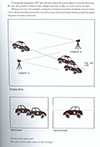Home
Overview
Techniques
Prior Knowledge
Pop Culture
Task 1:
Written Response
Task 2:
Investigating Pop Culture
Task 3:
Produce a Music Video
Task 1:
Written Response
Task 2:
Investigation
Task 3:
News Production
Critical Skills & Processes
Narrative
Media Narrative
Codes & Conventions
Representation
Semester 1
Semester 2
Semester 1 - Course of Study 2A MPA (15 Weeks)
Welcome to Semester 1 of the Media Production and Analysis course at Swan Christian College. This semester is going to be filled with wonderful new learning experiences, as you engage with media in different ways, - analysing, deconstructing, and creating. You will be working with your friends to produce your very own Music video, just like the ones you see on TV! Of course, the people on TV have gazillions of dollars to spend on music videos sometimes, but very often the best clips are done on very low budgets - they just have great ideas! So, this is your chance to be creative, explore your great ideas and with a little help from your teacher, make those ideas come to life.
Our broader context this semester is Popular Culture, or POP Culture. We will begin the semester with some research on POP Culture which you will present in a web page. We'll then move on to analyse and deconstruct a variety of Music Videos from different genres of music. We'll consider them from a theoretical perspective as well as a production perspective in order to tool you up with the necessary understanding and skills to create a great Music Video of your own. Finally, you'll be working on your own Music Video, which should be a culmination of all you have learned this semester, and demonstrate a thorough understanding of POP Culture and Music Video.
Group Work
Group work is an essential part of Media Production. It is imperative that you actively contribute, but that you also know when to listen to those around you. A good production team is a happy production team, and respect and consideration for those around you is essential. Don't expect others to do everything. Enthusiastically volunteer for jobs, even if you're not brilliant at them - it's your chance to learn.
Individual Work
Of course, there will be times when you need to focus, and get on with your own individual work. The harder you work at these times, the better you'll be prepared for your group work, so you will find others will want to work with you, and you will be an important part of that group.
Setting UpBefore you start anything! A big part of Media Production is being organised. Film and Television Producers are basically organisers. They get the funding, decide who to employ - which directors, cinematographers, editors - and manage the whole thing very well. There is a shortage of good producers in the Film and Television industry, and if you develop good management skills, you could go a long way in a very exciting career. At school, a big part of being organised revolves around keeping neat folder and file naming and organisation. As a media student you will have special privileges which you need to work responsibly with. You will have access to the brand new mac lab which will have a different work flow from which you might be used to. NOTE - Any careless behaviour with this equipment will be severely reprimanded and could result in you being removed from this class permanently! The computer you work on from day 1 is the computer you will stay at throughout he whole year - THIS IS VERY IMPORTANT!You will keep all your personal media related work on the local drive of that computer in a folder called the 'documents' folder.You will have access to a 'shared folder' (called MediaShare) where you can swap SMALL files for group work. In exceptional cases you might need to transport large video files to another computer - this will be done using the class external drive (ask teacher for this).NOTE: Be sure to back up all important documents onto your own personal storage device (ie: thumb drive or external drive).Congratulations! You're ready so start! Click here to continue
Semester 2 - Course of Study 2B (18 Weeks)
Welcome to Media Production and Analysis Unit 2B.
In this unit you will focus on learning contexts related to press and broadcasting in which you will further your understanding of non-fiction forms and genres. You will view, listen to and analyse a range of journalistic and documentary forms, undertaking research into the representation and reporting of cultural groups and issues. Areas of press and broadcasting that will provide learning contexts for this unit will include Australian press, photojournalism, television news and documentary film.
After completing Unit 2A last semester, you will be aware that there is a huge amount of work and organisation that goes into any successful media production. Make sure you manage your time well, and choose interesting subjects and topics to help you enjoy the fact that you WILL NEED TO SPEND TIME OUTSIDE OF CLASS TIME WORKING ON YOUR MAJOR TASKS.
Please note: It is imperative that we have all assignments completed by the due dates in order to complete this unit of study, so please ensure you are on task and that you discuss with your teacher any and all difficulties you may be having.
Music Video Techniques
WHITE FLASH
In the olden days films were all produced on celluloid - yep, the old style cameras that took 24 little pictures every second to produce the illusion of movement. These cameras were much more 'mechanical' than today's digital video cameras, and the time that the lens was held open defined how much light hit the film, which gave you an accurate image.
This exposure was calculated based on the fact that 24 images were taken every second that the film was running, but the camera took some time to speed up to 24 frames per second, and also took some time to slow down to a stop at the end of a take. Of course, this time was short, but it was long enough to produce a white flash at the beginning and end of each take with many of the old film cameras.
Today, music video directors like to imitate this 'fault' and use it as a stylistic tool. Very often music videos have many white flashes in them, as you will see as you watch the video linked on the right side.
CLIP SPEED
Clip speed is very important in the production of music videos, as well as all kinds of other film and video production. We have all seen slow-motion and fast-motion used for various reasons, and you need to know how to use this technique, as it is a valuable tool.
Ramping
One technique often used in TV commercials and music videos is called Ramping. Ramping is when a clip speed is changed during the playing of the clip; for example, in car advertisements, a car will be coming around a corner, then just as it goes past the camera (nice, close and in all its glory) the image slows right down. It then may speed up again as the car leaves the screen or drives off into the distance.
Time Lapse
Time lapse is very fast motion - so fast that we see movement that is not even visible to the naked eye. The sun or moon rising, a flower opening, or clouds zooming across the sky are often shot in time lapse.
Watch the videos linked down the right side of this page. Watch for fast and slow motion clips speeds, examples of time lapse, and keep an eye out for examples of ramping.
SLOW SHOOT, FAST PLAY | FAST SHOOT, SLOW PLAY
Often in music videos the director wants the musicians, characters or setting to appear somewhat alien or surreal. One way of achieving this is to shoot the subject moving, acting, singing or playing in slow motion, then speed the clip up until they seem to be at a 'normal' speed. The result is that, even though they appear to be 'normal' in speed, they look a bit jerky and weird. The other effect is that the surroundings are going very fast, making the environment seem surreal.
Of course, you can try the opposite, where you act fast and slow the video down - this also produces wonderful results.
Watch the clips linked down the right side to see some examples of this effect, then go shoot your own footage and try and duplicate it.
B&W AND TONAL DROPOUT
Often in music videos you will see the use of Black and White images. This is not because the producers only had very old camera equipment, but rather a stylistic decision made by the director of the clip. Sometimes extra effects might be applied in order to further enhance the old film look, or, the image might not quite be black and white with just a hint of colour.
Have a look at the music videos and clips linked down the right side.
Spend some time experimenting with image colour, and see what kind of cool effects you can create in premiere pro.
JUXTAPOSITION
Juxtapose vs place side by side
Juxtaposition in film is used by film makers to create meaning in the audience's mind by positioning different shots next to one another. If the two images are not commonly put together then it forces the viewer to stop and work out what it means. Often, when juxtaposition is used in this way, a complete break in terms of time, space and subject is common, with images being used to stimulate the viewer emotionally and intellectually. For example, a woman being administered an injection could be inter-cut with images of a vicious dog snarling. The dog may have nothing to do with the woman, the drugs or medication, but adds valuable meaning to the sequence.
See this clip for examples of Juxtaposition, as used in Blossom.
See Blossom Party for another example think about how the meaning of this scene is changed by the dying flower. Tell someone next to you and see if they agree.
How does the cat eating the mouse change or add meaning to this clip?
FAST MUSIC - SLOW IMAGES | SLOW MUSIC - FAST IMAGES
Often when we listen to a piece of music, we tend to think that fast music would naturally work well with fast paced images. Not only would the video images be of racy, paced scenes, but the editing would be fast as well, with clip lengths as short as a small fraction of a second.
Consider the movie Baraka. What kind of images and music do we see assembled together here?
Just as juxtaposition of two very different images can communicate a third meaning, so can the use of seemingly 'opposite' music and images.
Watch Buyers of Benetton to see a fairly up-beat music video that uses slow-motion for the entire clip. Then have a look at this clip, to see fast images to slow music.
Write down your response to these clips in your journal or visual diary.
EDITING ON & OFF THE BEAT
Editing on the Beat - or off it?
When editing to music, it's often good to edit on the beat. This means the image cuts to the next image in synchronisation with the musical beat. Often, however, the best place to cut is just either side of the musical beat. Experiment when you're editing and see how the beat affects the impact of your edits.
Find some music with a strong beat, and practice editing to the beat. Try half a minute of editing exactly on the beat, then experiment with different timing for the rest of the musical piece.
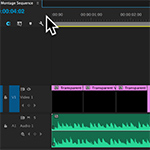
WIDE ANGLE LENSES
The availability of a wide angle lens can make a huge difference to your video and film production. The normal zoom lens on a typical camera has a degree of use, but a really wide angle lens can be a very beautiful thing.
Having a wide angle lens can be handy when shooting hand held footage as it helps smooth out any movement. This technique is employed on many skateboarding videos as the wide angle allows the cameraman to be close to the action and still fit the whole skateboarder into the frame while keeping the shot steady as they move with the action (usually on another skateboard!).
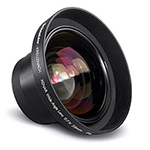
COLOUR MANIPULATION - CRUSHING GAMMA
'Unaffected' video is almost never used in music video production. That means, if you go and shoot some video, chances are you will need to put it through some kind of image processing in order to give it a nice stylised look. There are several colour correction and manipulation tools in Adobe Premiere Pro that you can use for this.
For more advanced colour manipulation export your clip for processing on the 'big man' using Magic Bullet Looks.

PICTURE IN PICTURE - WITH JOHN BUTLER TRIO
Picture in Picture tends to be used more in documentaries and current affairs programs than in music videos. It can look good in a music video, however, to use an adaptation of the picture in picture, where an image is cropped and scaled, perhaps with a soft edge or some kind of border. You can also try using two or three clips on the same screen, all scaled and positioned to look good.
See the first John Butler Trio clip as a good example of this kind of effect.
Look at this trailer for Oceans 13 that uses multiple clips within one frame.
Have a look at videos that demonstrate these effects, then spend some time trying to duplicate some of the stylistic elements of the videos.
JUMP CUTS - BREAKING THE RULES
Jump cuts happen when two shots similar in composition and framing, and of the same subject, are cut together.
It can be very disconcerting for your viewer, and can look very silly. However, when you make music videos you have licence to experiment by breaking the rules!
Sometimes a combination of jump cut with white flash or some kind of motion effect can look great.
Spend some time shooting and editing your own sequence of jump cuts.
Click here to view a scene from Amelie that uses jump cuts to great effect!
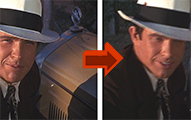
ALPHA MIX
As you spend time working in film or video production, you will eventually come across Alpha.
Alpha is the term used to define transparency.
Alpha describes the degree of transparency in a certain image or clip, whereas Alpha Channel describes an area of transparency in an image or clip.
Alpha is generally measured in units from 0 to 256, and can be seen as a gray-scale image. A grey-scale image (a black and white image is grey-scale, and has 256 degrees of 'greyness' from black to white) can be used as an alpha channel between two images. In this case, one image will be visible where ever the alpha channel is white, the other image will be visible where the alpha channel is black, and there the alpha channel is grey there will be a mix of semi-transparency.
Prior Knowledge
Having chosen to participate in the Media Production and Analysis course of study, it is assumed that you have had some Media Studies training in lower school. If you haven't done any previous study in the Media area, you will have a little catching up to do. This isn't a huge ordeal, and with a little commitment, you will find you have caught up on your peers and are well able to engage intelligently with the upper school course - learning how media works, and getting creative!
The tabs below will give you some introductory information that you will need to be familiar with, including a few short exercises to get you up to speed.
Some examples of past students work: Student Video Archives
Framing & Composition
Continuity and the 180 degree rule
Juxtaposition
Every form of communication has some kind of basic grammar, or rules, to make communication more efficient and affective. Many of today's televisions still make use of 4x3 screen dimensions but this is quickly changing to 16:9 wide screen. As such in our shooting context we will be using 16:9 wide screen as this soon will be the standard in Australian television. Considered use of framing, composition and camera angles within this context will greatly assist communication - increasing your viewers' pleasure.
Here are a few guidelines that you should consider before you press the record button on your camera. Make sure you're confident about recording quality images before you start using up your tape.
Framing
- When framing people, you should generally put their eye-level about two thirds of the way up the screen.
- In medium shots, leave a little headroom - space between the top of the head and the edge of the TV screen.
- If the person you're shooting is looking off-screen (not directly into the camera) make sure you leave some 'nose-room', or 'talking space'.
Rule of Thirds
Horizontal lines, like the horizon, can look boring if you place them in the centre of the screen. They look much better one third fom the top or bottom. The same applies for vertical lines - put vertical objects one third in from the left or right of the screen. If you divide your screen into thirds, both vertically and horizontally, the four intersecting points are 'points of interest' where the eye is naturally drawn. Consider these 'sweet-spots' when framing up.
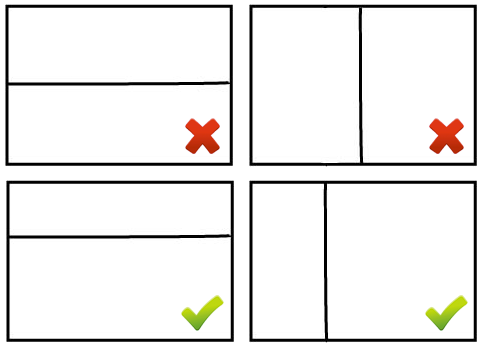
Camera Angles
Eye-Level Shot: The camera is horizontal to the ground. In a wide or mid-shot, the camera should be at the eye-height of an unseen observer. With closer shots, the camera should be at the eye-level of the subject being filmed.
High-Angle Shot: Where the camera is higher than the subject being filmed, and tilted down. These shots make the subject look inferior, weak or powerless; making the viewer seem powerful or superior.
Low-Angle Shot: The camera is lower than the subject and tilted upwards. This angle makes the subject appear powerful, strong or superior.
Jump-Cuts
Jump cuts happen when two shots similar in composition and framing, and of the same subject, are cut together. It can be very disconcerting for your viewer, and can look very silly.
To avoid jump-cuts, make sure the framing of the subject is substantially different between shots if they are of the same subject. You can do this by moving the camera closer or further away from the subject, zooming in or out, or movng the camera to a different angle (from front on, to a half-profile shot). Where you DO have two shots that are very similar, you can hide it by using a cut-away or cut-in.
Click on each of the pictures down the right hand side of the screen. Make sure you understand them fully before you take a camera out to complete this exercise.
The 180 Degree Rule
When you are shooting any scene, you will need to follow the 180 degree rule for your scene to make sense. If you don't follow this essential rule, your scene will not look continuous.
The first step in following the rule is to establish the 'line of communication'. Once this imaginary line is drawn, all shots are taken from one side or the other, but NEVER do you shoot from BOTH sides of the line. Click here for a great web page that illustrates this idea.
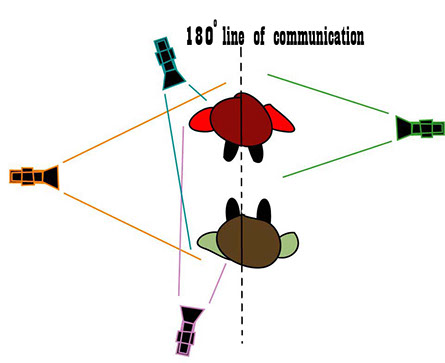
In the above scene, the orange, purple and blue cameras will all edit together well. The green camera is the wrong side of the line, and will cause problems in editing.
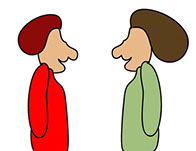
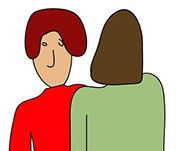
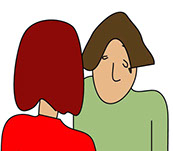
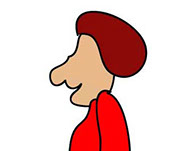
Click the thumbnail below and read it. When you're confident that you understand continuity and the 180 degree rule, do the continuity exercise.
Juxtaposition
Juxtapose means to place things side by side to create meaning.
Juxtaposition in film is used by film makers to create meaning in the audience's mind by positioning different shots next to one another. If the two images are not commonly put together then it forces the viewer to stop and work out what it means. Often, when juxtaposition is used in this way, a complete break in terms of time, space and subject is common, with images being used to stimulate the viewer emotionally and intellectually. For example, a woman being administered an injection could be inter cut with images of a vicious dog snarling. The dog may have nothing to do with the woman, the drugs or medication, but adds valuable meaning to the sequence.
Example:
1. Flower and Dog:
Initial reaction - Violence and fear.
Considered response - Sometimes things aren't always as they seem at first glance. Flower could be poisonous.
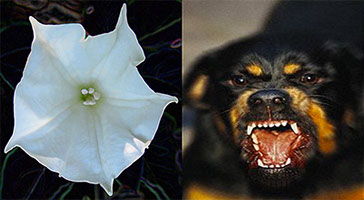
Pop Culture
Originally, Popular Culture was a term used by writers (who belonged to the educated class) to distinguish what was enjoyed by the 'masses' from what was enjoyed by the wealthy or educated classes. Popular Culture therefore had connotations of being vulgar and cheap.
In today's world, Popular Culture is a term given to products and practices that are well-liked by many people. Popular culture embraces media works that are current, and that are produced for and appeal to large audiences, being fashionable, youthful, and commercially appealing.
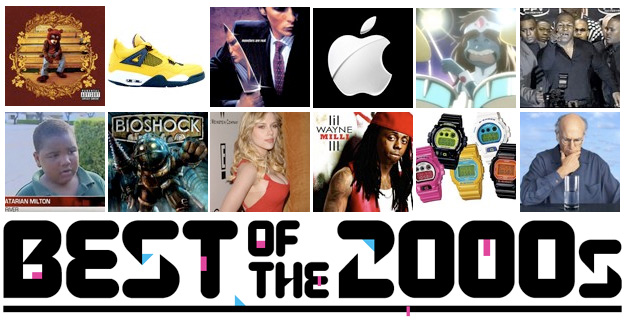
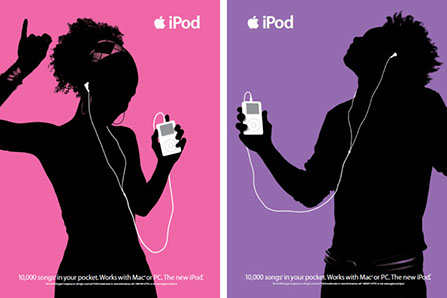
Those who are quick to criticise the products or practices of Popular Culture generally oppose them on the ground that:
Products of Popular Culture are:
- mass produced
- designed and produced primarily to make a lot of money
- produced for and appeal to a mass audience
- predictable, following popular formulas
Products of Popular Culture are not:
- unique works of art
- born of the desire to produce creative and aesthetic works of art
- produced to appeal to those with 'good taste'
- original
Popular media products usually fit the popular culture mold, and are often subject to criticism.
To understand where the criticism is coming from, it helps to know more about high and popular culture.
High Culture
High Culture is linked with products associated with quality and perfection. The ballet, opera and the theatre are products of high culture. Audiences originally came from their higher social classes and are still willing to pay enormous prices to participate in a 'one-off' or 'once in a lifetime' experience. Products of high culture are also associated with educational value and are therefore considered worthy.
Popular Culture
Popular Culture is linked with products associated with immediacy and production line manufacturing. Tabloid press, popular music and video clips, fast food outlets, advertisements, reality TV and video games are just a few products born of popular culture. Audiences are from all walks of life and can not only enjoy what popular culture has to offer, but more importantly, can usually afford it.
Popular Culture is not exclusive and it is not static. It is constantly changing to accommodate new lifestyle trends, as well as new trends in media production and use. Products and practices may not sustain the test of time, but when they do, their financial worth is phenomenal. Ultimately, the purpose of popular culture is to make 'obscene' amounts of money in a very short time. This can often be at the expense of educational or intellectual worth; however, Popular Culture never pretends to be anything other than popular.
It is fun to debate the value of worth of media works and many of your conversations will focus on media that is spawned by Popular Culture. What is important is that you can move beyond simply making value judgments about media works. You will appreciate them even more if you can see them as cultural products that connect to our culture.
Products of Popular Culture are worthy in their own right
You will view, listen to and analyse a wide range of popular media texts and learn more about trends in our culture that shape popular media production and use. You will further develop you ideas and production skills and create your own media works.
Popular Culture is a dynamic area of study that encompasses Media Language, Audiences, and Production in a variety of learning contexts.
Task 1 - Written Response (individual task)
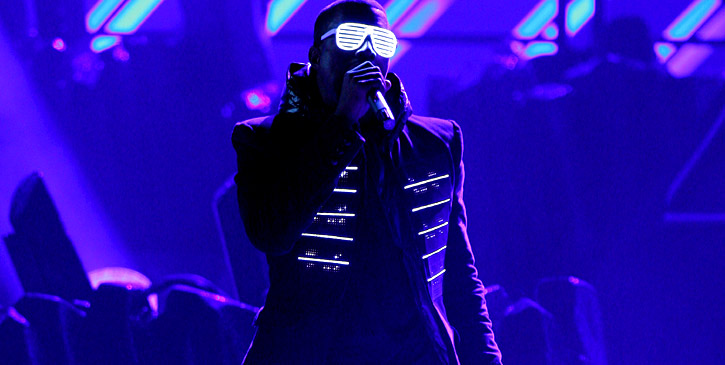
For this task you are to choose 1 of the 6 selected music videos below for analysis.
- Identify the genre of the clip by its use of narrative elements (characters, setting, conflict, resolution). Explain the specific codes and conventions (SWAT - don't use this term in your writing though) used in the video. How do the codes and conventions create meaning for the audience?
- Define the term 'sub-culture' in your own words. Reflect on why this video might be popular with particular audiences, discussing the specific sub-cultures the video might be trying to connect with. Discuss the producer's possible motivation in reaching this audience.
- Define the term 'values' in your own words. What values are put forward in this video? Are they consistent with the dominant values of our society? Do they connect with your own values in any way (This question isn't an opportunity to bag out the video, but to compare your personal values with the message of the video)?
QUALITY IS MORE IMPORTANT THAN QUANTITY BUT AIM TO WRITE 1500 WORDS & BE SURE TO REFERENCE YOUR RESEARCH APPROPRIATELY!
VIDEOS
Task 2 - Investigating Pop Culture
Pop Culture has been defined as "a commercial culture based on popular taste". Individually you must investigate a specific media product that belongs to Popular Culture in the form of a web page that includes written information, related images and appropriate links. In the past topics have included:
The Simpsons, Marvel Comics, MTV, Neighbours, Elvis, Disney, The Beatles, Various Reality TV Shows etc.
Be sure to choose a topic that you both are interested in, and will allow you to cover the key points adequately!
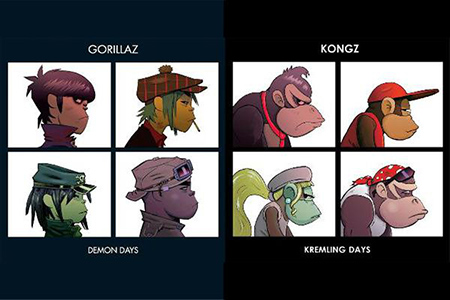
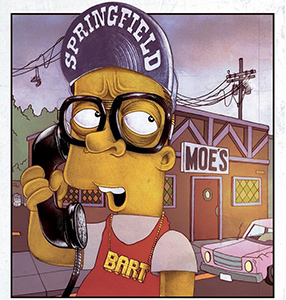
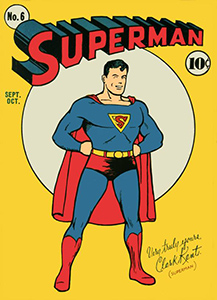
As a minimum you must address the following ideas:
- Introduction Page - What is Pop Culture, how do we recognise it and why is it created? What features of your chosen topic characterise it as Pop Culture?
- The Context - Where was it produced? What else was popular at the time? Did any world events or cultural issues shape the product? What was the impact on society at the time of it's popularity? How did the technology of the day shape the product?
- Values - What values are put forward in your media product? Are they consistent with the dominant values in our society? Do they connect with your own values in any way?
- Representation - How are selection processes used to represent people and events? Are any stereotypes used and for what purpose?
- Controls and Constraints - what specific controls and constraints {PETBAT} have shaped your media product?
Click below for past years student examples:
- 2007 - MTV
- 2008 - Marvel Comics
- 2009 - Friends and Biggest Loser and Star Wars
Learning context - Pop Culture
This may be done individually or with a partner.
For best results try following these steps:
Step 1 - Collect Information
Find as much information as you can about Pop Culture and your chosen topic.
Step 2 - Analyse and Interpret
Consider the following questions in relation to our chosen topic:
- What is Pop Culture, how do we recognise it and why is it created?
- What features of your chosen topic characterise it as Pop Culture?
- Who are the consumers of Pop Culture?
- What are some different perceptions of Pop Culture?
- Who creates and controls Pop Culture, eg. special groups, institutions?
- How does Pop Culture contribute to culture, society and social change?
note: outcomes 3 and 4 are relevant to this section
Step 3 - Web Presentation
Create a web site to present a report on your Pop Culture topic. Make sure the design of you web site appeals to a Pop Culture audience, and include all of your written information, related images and appropriate links.
note: outcomes 1, 2 and 3 are relevant to this section
Task 3 - Produce a Music Video
In groups you are to plan and produce a broadcast quality music video for a current song. You must consciously think about who your intended audience is and use appropriate codes and conventions to create a compelling video. The genre of your chosen musical style will help shape the style of your video - refer back to your task 1 response on music video for ideas on techniques you can use in your own videos. For more ideas and inspirational videos click here.
You have the choice to:
- Produce an original video for a local band - with the goal of getting the video aired on Rage.
- Produce a video for an existing popular song. For example you could do a remake of A Spice Girls Video.
Documentation & Planning
After forming the groups you will need to brainstorm some ideas and decide on the concept for your music video (make sure you make detailed notes in your visual diaries outlining all your ideas).
Before you begin filming you must 'pitch' your video idea to your teacher which will be in the form of a one page written treatment. For more information on what a treatment is and how to write one click here.
You must also complete a design proposal and production schedule outlining your groups goals and intentions for the projects. Pre-Production document
Once filming begins you must continue to document your thoughts in your visual diaries outlining what worked and didn't work throughout your production.
No Planning = No Filming
Learning context - Popular Music and Video clips
This task is to be done in groups of 3 or 4. For best results try following these 4 steps:
Your music video needs to demonstrate: The ability to plan and function in a group-production environment.A thorough understanding of how music videos are made to appeal to audiences.An understanding of representation and stereotypes.The development of skills - shown by the appropriate use of techniques as listed down the left side of this page. Before You Begin You should remember studying concepts and rules such as the 180 degree rule, shooting and editing for continuity, juxtaposition, framing and composition. If you can't remember what these things mean, have a look at the prior knowledge.If you know how to work well with the video and film medium... well, we're about to throw out a bunch of the rules. Yep, when you're making music videos, you need to work with one overriding concept in mind; making video is a play of light and colour! you may still work within the conventional frameworks, but you're also free to break the rules in order to create something that is visually pleasing and works with the music. Click on the nav menu Techniques at the top of the page to explore some of the tools you need to complete the tasks to a high standard - and produce a great clip! Codes, Conventions and Media Audiences - The Music Video Just as there are different genres of music, so there are different genre of music video. Music and video often mesh together fairly naturally and a certain aesthetic becomes a convention for a certain type of music. Examples of this are the story in rock videos about a young person going out and finding themselves through trials and adventures, or dance videos featuring dramatically lit beautiful people dancing in unison. Audiences: Most videos fit into the mold laid down by audience expectations, and people enjoy the way what they see compliments what they hear. A video may be successful if it does this exceptionally well, and brings something new to the song (ie: Ok Go) , as well as powerful emotions to the audience, or the video may do well by doing something completely new and pleasantly surprising the audience (Peter Gabriel, Sledgehammer). Sometimes videos mock the conventions of another type of music's characteristic videos (Blink 182, All the Small Things, or Red Hot Chilli Peppers Dani California), or they play with the normal conventions of their own musical genre (Mariah Carey). The Importance of Videos: Videos used to be made to promote a song to the audience, but what is undeniable nowadays is that in many cases it is not clear if the music or the video has primacy - they work together in relationship to sell a certain idea or emotion to the audience, and if you have a good video, it could just about make your musical career. Big Budget Versus Low Budget: It is also interesting to note that oftentimes a music video can cost more to make than an entire album! Record labels hope these videos may attract enough attention and publicity to result in enough record sales to justify the expense (ie Michael Jackson, U2/Green day video). However some of the most interesting and memorable videos have been made for little more than the cost of a tape and camera hire. Fatboy Slim's 'Praise You' video was shot in one take on a camcorder - the idea however was clever, and therefore the video was effective. Another example of this idea can be seen in the treadmill video by 'OK Go'. These videos prove that the idea/story is what is most important, not the budget. So get out there and start creating!
Step 1: Pre-Production
Step 2: Production
Step 3: Post-Production
Step 4: Evaluation
Brainstorm and develop your ideas. For example:
- pace, images, codes and conventions
- audience appeal of the song/music
- narrative or non-narrative structure - or a mix of both
Explore:
- how to manipulate video technologies, eg. special effects in camera and post-production
- techniques used in a range of video clips
- codes and conventions, eg. montage conventions, manipulating pace to match tempo, representation of characters
- narrative and non-narrative conventions
- codes and conventions used in promotional material (technical, symbolic, audio and/or written codes)
Communicate and present your ideas:
- draw up plans that include a time line, specific roles and responsibilities
- create a storyboard or written script that includes duration of shots and special effects
note: outcome 1 is relevant to this section
Apply skills, processes and technologies to record images and sound:
- develop and apply skills you explored in pre-production
- follow processes and apply technologies according to plans
Select and use codes, conventions and representations that will appeal to the target audience.
Carry out production roles and responsibilities as allocated.
Work within the given controls and constraints, eg. school policy, technologies, time, ethics, values of audience.
note: outcomes 2 and 4 are relevant to this section
Apply post-production skills, processes and technologies.
For example:
- lay music track
- edit video sequences and apply special effects
- add titles
- transfer to appropriate viewing format such as DVD and .MOV file.
Present your video clip together with your promotional material to an appropriate audience.
note: outcome 2 is relevant to this section
Evaluate your own media productions:
You are expected to keep a production journal in your visual diary. In this you should outline major steps in the production process, explain and evaluate the choices you made and evaluate the final production and promotional material.
note: outcome 3 is relevant to this section
Task 1 - Press & Broadcasting (2B) : Response
"A public hospital’s wretched inadequacy could not be shown more graphically or pitifully. No, the picture we publish on the front page today is not from Zimbabwe or some other Third-world hellhole dictatorship. It was taken in Perth…This is a picture of profound shame and disgrace. But the picture can’t lie …"
— The West Australian, Opinion - Pitiful picture of public hospital inadequacy, 24th January, 2007
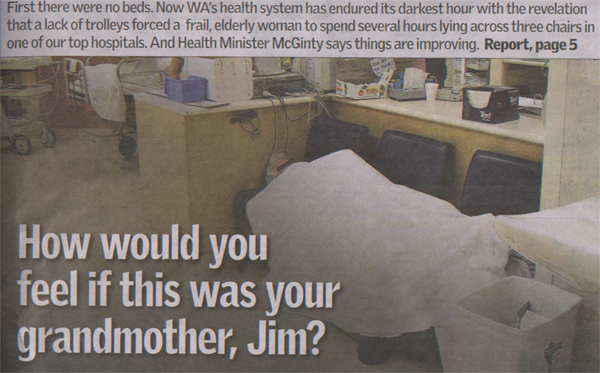
PART 1:
In part one of your essay you are to respond to the following newspaper article (click here for full article).
Begin your response by stating your initial feelings upon reading the story. Does it make you feel angry, sad, upset, indifferent?
In your response you must discuss:
- The producers preferred meaning - ie: what was the West Australian attempting to achieve/say through the story?
- The representation of the patient and any stereotypes used - how is the woman portrayed in the story? Are any stereotypes used and why?
- The values embedded in the text - what are some dominant values in our society that the text tries to appeal to and why?
Gayle Sargent: "I was shocked and embarrassed to see that my photo had been taken and published without my permission. I am 46-years-old. I am not a grandmother. Nor am I frail or elderly or suffering a neurological illness".
— Channel 7, Perth News, 24th January, 2007
PART 2:
Watch the channel 7 television news story
- How does this change your perspective on the story?
- With this extra information discuss the selection process involved in the front page story - what information was included and what was omitted by the West Australian?
- In your conclusion clearly discuss your thoughts on the problem of misrepresentation in media and the importance of being an informed viewer/reader of media products.
Word count - (2000 words approx 5-6 pages, font size 12, paragraph 1.5 spacing)
For more valuable information go to the Media Watch page
Click here to read the findings from the Australian Press Council regarding this story.
Learning Context: Representing issues and people.
This task is to be done individually. For the best results try following these steps:
- Carefully read the above newspaper story and view the television news story. Make notes on key points of both stories.
- Analyse, Interpret and Reflect: Note: Outcomes 3 and 4 are relevant to this section.
-
- Analyse each story and headline; identify positive and/or negative language and interpret the meanings created.
-
- Analyse the photograph: identify the codes selected in each image and interpret the meanings created.
-
- Reflect on the representation and whether a point of view has been constructed by the selection of words, codes and conventions.
-
- Reflect on what has been omitted in constructing the representation.
-
- Identify values associated with the positive and negative stereotypes used in both stories.
- Discuss how your cultural background has shaped your understanding and interpretation of the story and images. Suggest other possible interpretations, giving reasons.
- Discuss why these stories and images might have been published and explain their possible influence in your own community and on Australian society in general.
- Discuss the power of the media and the audiences role in deconstructing meaning in media texts.
- Conclude: Note: Outcome 3 is relevant to this section.
- Summarise how the process of representation reflects values by constructing a point of view.
- Present: Note: Outcomes 1 and 2 are relevant to this section.
Present your findings in an essay format.
Task 2 - Press & Broadcasting (2B) : Investigation
In this task you will be investigating the work of one of Australia's most influential photojournalists - Frank Hurley. You will be required to discuss his style, technique, values, and commitment to the art form. You will discuss the constraints that shaped his work, the context within which his photographs were seen and the impact his work has had on Australian society.
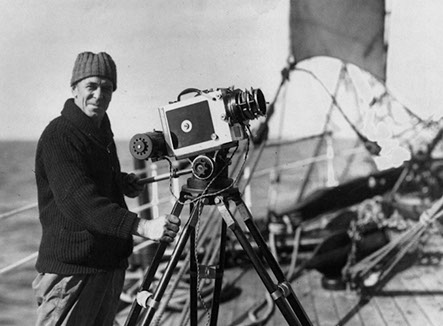
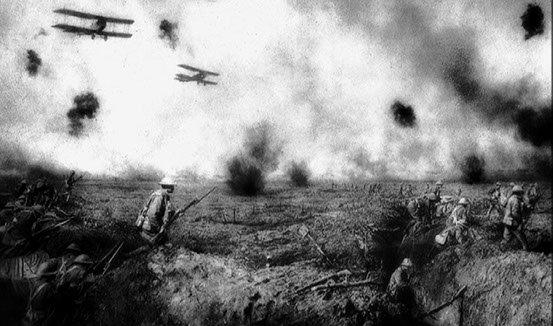
You are to produce a short (approx 3 minute) vlog (video blog) entry on an interesting aspect of Frank Hurley's life. This production must adhere to the standard codes and conventions of a vlog you would find on YouTube, including, but not limited to direct address to camera, on screen titles- but feel free to be creative in how you tell your story. Remember basic composition rules to create an aesthetic which will encourage your viewers to engage with your topic.
Many examples of creative vlogs can be found online - have a look around for some inspiration.
You are to investigate your topic thoroughly. This research must be documented in your visual diary and a written script must be submitted to your teacher for review before you begin filming.
Topics to choose from:
- Frank Hurley the world's first documentary film maker.
- Frank Hurley - Historian or Artist?
- Near Enough is not good enough - Frank Hurley's quest for perfection.
- Reconstruction of reality - Hurley's composite photographs.
- Hurley at War - the ethical implications of photojournalism.
- Captain Frank Hurley the adventurer and plunderer (Pearls and Savages - New Guinea)
- Hurley's attitude to race.
- Hurley's vision of Australia (The Squatters Daughter/A Nation is Built)
Links
Australian Screen (great info!)
National Library of Australia Photos
You will be required to work individually for this investigation. For best results try following these steps:
- Plan and collect information
Note: Outcome 3 is relevant to this section.
-
- Decide on your focus.
- Brainstorm ideas and draw up a list of questions to guide your research.
- Source and reference relevant information (not just wikipedia please!!).
- Carry out your investigation
Note: Outcomes 3 and 4 are relevant to this section.
-
Analyse, interpret and evaluate examples of your chosen topic considering factors related directly to the outcomes for this course. For example you could focus on the selection processes Frank Hurley undertook in his work:
- Information that he included, omitted, emphasised
- His use of narrative elements, codes and conventions
- How he represented people and events, his point of view and values.
- Investigate the cultural context at the time his work was produced and experienced. Find evidence of:
-
- When, where, and why the works were produced
- The purpose of the photos, for example: propaganda, to highlight a problem or an issue, to sell an idea, to make people question, to expose a wrong, to reinforce values.
- How the photos were shaped by available technologies and other constraints.
- Happenings and events in the world at the time the photographs were produced (ie political and economic climate, historical events).
- Plan and present your investigation
Note: Outcomes 3 and 4 are relevant to this section.
-
Organise your material into a structure that will suit your style and intended purpose.
- Plan your introduction: make sure you state the purpose of your investigation and give some information on how you went about it.
- Identify the key points you will make about your chosen topic.
- Use your research to expand on the key points.
- Include visual examples to illustrate the key points and make your production more interesting.
- Plan your conclusion: summarise your findings and express your own opinions.
- Draft, edit, and fine tune your script, making sure you acknowledge your sources of information.
- Present your planning to your teacher for approval before you start filming.
Task 3 - News Production
As a class we will be producing a full half hour current affairs program. We will create a program that uses all the typical codes and conventions of a current affairs program such as Today Tonight. However instead of producing serious stories we will be emulating the style of shows such as 'Real Stories' and produce a program with a humorous edge. See below for an example.
Visit the Today Tonight web page to analyse the codes and conventions used in Current Affairs Programs.
You will be split up into smaller groups to brainstorm and develop four original stories. You must write an original story based upon a 'lead' given to you by the program director (ie your teacher) and format your script using Celtx. Each member of the group will be assigned a specific responsibility but will be required to help out in other roles as required.
- Journalist (responsible for final script and presentation)
- Camera Operator
- Editor
- Sound/Music and Graphics
There will also be one person chosen from the class to be the main presenter for the program.
Once all stories are completed they will be combined into a full bulletin of pure hilarity.
Click here to View Past Student Current Affairs Bulletins
Each student will need to complete the 5 page writeup reflecting on their work.
Learning Context: TELEVISION AND JOURNALISM
You will need:
- to work as a class and in a small group
- you have 6 to 8 weeks to complete the task
- video and audio recording equipment, microphones, editing facilities, script formats.
For best results try following these steps:
Pre-Production: Note: Outcome 1 is relevant to this section.
-
Brainstorm or survey audience preferences, expectations and values to decide on:
- news story topics
- interviewee and interview questions
- approach, structure, point of view
-
Explore:
- recording technologies and techniques, eg: microphone type and position, recording levels, framing
- television news styles and conventions, eg: camera angles, inserts, voice over narration, music.
- Communicate and present your ideas
-
- draw up plans that include a time line and specific responsibilities.
- outline interview questions and a structure for the news reports.
- create a script or storyboard showing details of footage to be used, introduction and links.
- show how particular choices you have made relate to your audience's values and expectations.
Production: Note: Outcome 2 & 4 is relevant to this section.
-
Apply skills, processes and technologies to film or record the interview and the documentary:
- develop and apply skills you explored in pre-production.
- follow processes and apply technologies according to plans, but making modifications as required.
- Select and use codes and conventions that strengthen your point of view.
- Carry out production roles and responsibilities as allocated.
- Work within given controls and constraints, eg: school policy, technologies, production processes, time, ethics, audience values and expectations (outcome 4).
Post-production: Note: Outcome 2 is relevant to this section.
-
Apply editing skills, processes and technologies. For example:
- edit audio and/or video sequences.
- mix interviews, commentary, live footage or b-rolls, music and/or sound effects.
- Broadcast your news Bulletin on the Swan media web page.
Evaluation: Note: Outcome 3 is relevant to this section.
- Evaluate your own media productions by completing your 5 page write up.
You are expected to keep a production journal (visual diary). In this you should outline major decisions you made during the production processes, explain and evaluate the choices you made and evaluate the final production and audience response.
Critical Skills and Processes
FINDING AND COLLECTING INFORMATION
Clarify the purpose of your task by 'unpicking' the questions set by your teacher. Make sure you understand the main focus and all aspects of the task, discussing anything you ar not sure about with your teacher.
Find out where you can find information relating to the topic, consulting people such as the school librarian, local authorities and considering sources such as:
- books and journals
- newspapers and magazines
- video resources
- online resources which may include lectures, articles, reviews, biographies and opinions.
As you go, evaluate how reliable the source of information is. Try to discriminate between factual information and what may well be gossip or sensationalised reporting. If you find different viewpoints or perspectives on the same topic or issue, consider them carefully; different opinions will be useful in giving balance to your investigation.
Follow these guidelines for organising your information.
- Make a heading giving as much detail as you can about: the author or producer; the title of the publication, video or online information. and the date of publication., production or presentation.
- Paraphrase the information you consider to be useful.
- If you think you might want to use a direct quote, underline the phrase or sentence and make a note of the page number on which it appears.
ORGANISING, ANALYSING AND EVALUATING INFORMATION
When you have collected your data, you should organise it under headings appropriate to the research task, cutting and pasting your handwritten or computer notes to help you clarify your approach.
The next step is to analyse and evaluate what you have collected, putting down your own comments and ideas about each source, and making links between different ideas and perspectives. Have confidence in your own judgment and be prepared to question the vewpoints and opinions you are examining. By recognising the values underpinning the viewpoints and opinions or writer, you will become more aware of your own beliefs and values, and this will give you more confidence to communicates your own ideas.
PRESENTING INFORMATION
Draw up a plan for your presentation and write your first draft of what you want to say. It is now time to consider the form of your presentation: essay, report, oral presentation or multimedia presentation.
Essay
- Plan your introduction, stating the purpose of the research and how you intend to present the findings.
- You may use subheadings in an essay to clarify the purpose of each major point, or you may simply proceed to discuss your points, allocating a paragraph to each. Each paragraph should have a central focus.
- If you want to use a sentence or paragraph written by somebody else, use quotation marks around the quote and write the name of the author and page number of the source in brackets immediately afterwards.
- Write a conclusion, summing up your findings and opinions without just repeating what has already been written.
- Finish with a Bibliography, listing (preferably alphabetically, by author) all of the resource material you used.
Written Report
This will be a more formally organised written presentation using titles and headings to divide your information.
- Purpose of report
- Sources of information
- Introduction
- Subheadings for each section
- Conclusion
Oral Presentation
Writing for an oral presentation requires a different approach from writing an essay or report. You cannot simply write an essay and read it to the class. Rather, you should consider the following.
- Introduce your topic in a novel and interesting way - ask a question, make a provocative quote, show a short video extract...
- Modify your language to engage your audience (oral language is usually less formal) and speak as if you are really interested in your topic - this will be infectious.
- Organise your points so that you can teach the class about your area of expertise - if you have followed the above steps, you are now the expert on this topic!
- Use palm cards with headings and main points you can talk about, so that you can maintain eye contact with your audience as much as possible.
- Use pictures or video to enliven your presentation or perhaps provide handouts with points or questions to involve the audience; use your visual material when it is appropriate during the presentation (don't leave it all till the end) - it provides a break for your audience and should reinforce what you have just told them.
- After your main conclusions, finish with something memorable - another quote, an opinion.
Multimedia Presentation
This is becoming the most popular way of giving an oral presentation. All of the above points can be applied to a multimedia presentation and you have the advantage of having important points and illustrations on a screen large enough to everyone to see - including you. This allows you to concentrate on making your presentation more 'personal', adding your own comments to that others can see on screen.
You must keep all research notes so that your work can be authenticated by your teacher and by subject moderators. REmember, plagiarism (using other people's words without acknowledging them) is totally unacceptable.
EVALUATING YOUR OWN PRODUCTIONS
This is something you do informally as a matter of course. Every time you take a shot, record an interview or make an editing decision you naturally look at what you have done and decide how good it is. You need to be able to put these thoughts in writing or on to tape, so that your teacher understands the extent of what you have learned. Identifying and reflecting on what worked and what went wrong will also help you to improve your production work.
Your teacher will give you guidelines on how to evaluate particular production tasks but here are some general hints to help you show just what you have learned through the production process:
1. Evaluate particular choices you made and explain each of your decisions relating to choice of medium and message, choice of structure, techniques, codes and conventions, choice of 'talent'.
- How did different choices suit your purpose?
- How did different codes appeal to you? (for example, you liked the effect, it positioned the viewer to see the subject in a particular way, it created the meaning you wanted...)
2. Evaluate the production processes.
- What new production processes did you learn?
- Discuss reasons for changes you naked from your original plan.
- Outline problems you encountered, how you coped with them and what you learned from them.
- Consider more efficient ways in which you could have undertaken the production.
3. Evaluate the team effort
- What responsibilities did you have and what did you contribute?
- Were there any problems? If so, how were they overcome?
- What did others to? Who made a good contribution?
4. Evaluate the final product.
- How happy were you with the final production? did it meet your expectations?
- Did you get any feedback from others, especially the audience?
- How does your product compare with those of others in the class?
Your teacher can supply you with some sample evaluation forms.
Media Language - Narrative
A narrative is a story, and stories are central to all cultures. As well as giving us a lot of personal satisfaction, telling stories is a social behaviour. Stories bring people together. Over the centuries, people have gathered to share stories. Stories are passed down from generation to generation and become part of the cultural knowledge of families, communities and societies. They help to define our understanding of our world.
Think about some of the stories you have been told and put them into categories, for example:

Reflect on:
- how you came to know these stories
- different versions you have heard
- the impact of different versions and storytelling mediums
All stories are constructed. However, the same story will be constructed differently by different people and through different forms. All storytellers use conventions appropriate to the form and the audience.
When someone tells a story, they decide what they will select to tell and what order it will be put into. They will then decide how the story will be told and conventions that will be used. For example
- When you are asked 'What did you do at school today?' you are in a position to tell a story.
- You may decide to tell the story just as it happened and retell all of the events of the day.
- You may leave out lots of uninteresting things or envent details to make your day sound more interesting.
- You may make a story up just because you are a very good storyteller.
- Or you may decide there is no story to be told.
Basically you're in a position to select, order, omit, exaggerate or fabricate material.
Media Language - Media Narratives
Films, television, newspapers, magazines, radio, photographs, comics, cartoons, websites, and video games all tell stories. Each medium develops its own unique way of telling stories based on the technologies used, the production style, the target audience and the context in which the story will be read, viewed or listened to.
The media is essentially a storytelling institution. Media producers have perfected the retelling or re-creation of stories through a variety of forms. Embedded in these stories are values, and these will reflect the values of the society in which the story is created and told.
The media use and develop the same elements that have always made stories interesting. Many people are involved in constructing media stories and they usually begin with an idea. The idea may stem from personal experience, something that has happened to someone else, a visual stimulus or a story that has already appeared in a book, play or comic form.
- They create characters that audiences will recognise and empathise with.
- Characters are placed in settings that define when and where the narrative takes place.
- They are confronted with conflicts through which the story is developed.
- These conflicts have resolutions that usually come at the conclusion of a story and are likely top be satisfying to the audience.
Media narratives are constructed through the development of four elements; characters, settings conflict, resolutions.
CHARACTERS
Media narratives depend on characters. Characters have the ability to engage readers, viewers and listeners in a media narrative. They make us laugh or cry, they make us angry or frustrated, and they can make us believe that they are real people rather than the inventions of a writer or producer. They have been carefully constructed to be believable, to fit our expectations of particular roles and character types and to tap into our emotions.
Constructing Characters
Appearance
Although we are told to 'never judge a book by its cover' we do make judgments about media characters, firstly according to what they look like, but also according to how they speak and behave. Our firs impressions take in their hairstyle, facial features, clothing and body language and we start to categorise them as, for example: cute, dishonest, reliable, arrogant, trusting... Their appearance may also encourage us to guess what their occupation might be.
Actions and Behaviours
Characters are further developed by their actions - their specific mannerisms and also how they act in different situations with different people. For example, they may have an authoritative manner, be overbearing, outgoing, sympathetic, indecisive, groveling, disrespectful, rebellious...
Voice and Speech
Closely linked with behaviour, the tone of voice, accent, choice of words and style of delivery will round off the characterisation that is constructed.
Characters are constructed in fiction and non-fiction stories. Some characters are constructed as stars, others as supporting or bit players. They all position audiences to become involved in the narrative and make sense of it.
SETTINGS
The setting is significant for grounding the narrative or putting it into a context that audiences recognise. Each time we are introduced to a narrative we look for clues that will tell us what the story might be about. We want to know the time and place; that is where and when the narrative is set.
The setting also places limits on the types of characters and conflicts that are acceptable and helps shape our expectations of the narrative.
CONFLICTS
Conflicts are essential in driving the plot or storyline; conflicts are needed to create interest in the narrative. Conflict may be:
- conflict with other characters
- inner conflict
- conflict with society
- conflict with nature
It is through conflicts that we get to know the characters better; we see how they behave in different situations and how they treat other people; we learn what they value and what causes them to behave as they do.
RESOLUTIONS
The resolution to a narrative is related to the conflict and to the cultural values held by audiences. Audiences want to be satisfied at the end of a narrative and they will be satisfied if everything is resolved according to their values, that is, that they believe to be right and wrong.
The genre (or type of narrative) will also determine the resolution of a narrative. For example, the villains in a fairytale must meet a grisly death while the goodies live happily ever after. A fairytale ending is expected in many popular media narratives. On the other hand, in some genres such as news, film noir or social realism, resolutions are more open and less predictable.
Codes & Conventions
Codes and conventions are tools that media producers use to construct messages in their media productions. As media students we must become very familiar with these, so we can deconstruct how these products are made and analyse how these messages are created.
Producers construct preferred meanings and viewpoints through the careful selection of technical, symbolic, written, and audio codes. An understanding of how these selection processes affect the meaning, realism, and viewpoints in a range of media is an essential skill in this course.
SYMBOLIC
For example - Settings, objects, appearance and body language, colour, lighting.
WRITTEN
For example - Size and style of print, captions and headlines, speech or thought bubbles.
AUDIO
For example - Dialogue, music, sound effects.
TECHNICAL
For example - Framing, movement, lighting, juxtaposition, montage, special effects, editing.
Representation in the Media
All people we see in the media are representations. We know that they are real people but they have been re-presented through a particular media form. The audience sees a mediated version of the real person. Someone has intervened, making decisions about how that person should be seen.
This concept is easy to accept in a fictional narrative. We know that actors are representations. They are playing a role created by a writer or director and that role might involve playing a character who is strong, loyal, treacherous or weak.
In non-fiction narratives, the notion of representation is more complex. We see photographs in newspapers of people such as politicians, unionists, footballers or students at a school ball and we know they are real people. Yet the photographer has captured a particular instant in time, choosing the lens, camera angle, and particular codes to suit the purpose and create a preferred meaning. What we see is a representation of the person, not the real person.
Similarly in broadcast and digital media, selection processes shape how we see real people. This can be seen in the image that a particular star or band might put forward through the media. This is usually a conscious construction that helps a stars image so that they can be identified with a particular sub culture and audience. The star depends on audiences recognising and approving of the image that has been created.
STEREOTYPES
A stereotype is a recurring representation that reduces something complex to something simple. It is an over-simplified representation of a group of people.
Stereotyping results in a whole group of people being lumped together in a single category, for example teenagers, housewives, Aborigines, policemen. Certain adjectives and symbols are chosen to describe and express judgements about the group. While particular characteristics are chosen as representative of the group, many other characteristics are ignored. The chosen characteristics are then applied to all individuals in the category.
People may be categorised according to things such as:
- Age
- What they look like
- How they behave
- What they do for a living
- Their ethnic group
- Their gender
- Their customs
Information sourced from Media Production & Analysis by J. Kean & J. Mc Mahon
Semester 1
Semester 2
 Swan Christian College - Media Department
Swan Christian College - Media DepartmentSITE MAP
MEDIA TEAM
©COPYRIGHT - SWAN CHRISTIAN COLLEGE 2017
CONTACT

